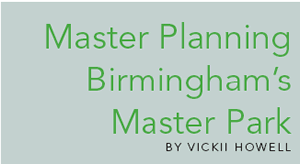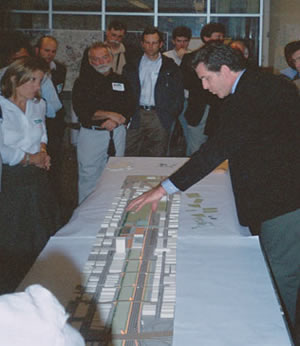

Tom Leader leans over a long table, throwing bits of green cardboard paper onto a long 3-D model of the proposed Railroad Reservation Park in the center of Downtown Birmingham. The pieces of paper represent an amphitheater, a ball field, a body of water, or some park component that could potentially fill a narrow strip of unused space in the heart of the City. If too many pieces go into the space, he explains, the park would become crowded with too many activities. Then, citizens who came to a public planning session split off into groups, and brainstormed about what they would like to see in the park. For five months, two consultants have been baptized by an avalanche of ideas, thoughts and wishes from citizens involved in a massive community planning process. With assistance from local architects and engineering firms, they’ve taken that information to create a workable blueprint for what could be Birmingham’s most innovative park project since the Olmstead brothers – renowned landscape architects of the early 1900s – laid out Linn Park.
Called “Birmingham’s Central Park,” the grand design emerging in a narrow strip of land from Sloss Furnaces on the east to Trinity Steel on the west is a cultural attraction that could feature:
“It looks really nice,” says Floyd Pharo Jr., who was visibly impressed after seeing the plan during a July public hearing. “So, when can we start?” |
|
SUBSCRIBE l ABOUT US l FEATURES l PERSPECTIVES l LATEST VIEWS l COMMUNITY CHEST Website
Development: Deidre Ali Creative
Services, LLC |


